Compare Roofus with the top 8 traditional tools it can replace and get as nerdy as you like about it

With the square lock (3) engaged, The Roofus® can mark 90-degree and 45-degree angles via reference of edges (4) and (8) on material without any adjustment. The Roofus® can also mark rafter plumb cuts and seat cuts via edges (4) and (6), without the guesswork and hand-eye coordination requirements of The Speed® Square. The Roofus® marks seat cuts via a purpose-designed reference edge (6) simultaneously with top/plumb cuts via edge (4) so you don’t need to ‘eyeball’ the accuracy of anything, or adjust settings during use. Unlike The Speed® Square, Roofus® can mark any desired angle in both directions from a material’s edge via its primary and secondary angle configuration settings (see userguide pages 12-19), rather than being limited to the one secondary configuration like the Speed® Square.
The Roofus® also consists of the same three angular scales found on the Speed Square (9,10 & 12), plus the unique advantage of an extra hip and valley scale calibrated with traditional degrees (11) which is exclusive to The Roofus®.
Variations of a try square can also be achieved with edges (4) and (6) with the position and depth of the blade (1) adjustable. The Roofus® extends well beyond these capabilities, we are just getting started.
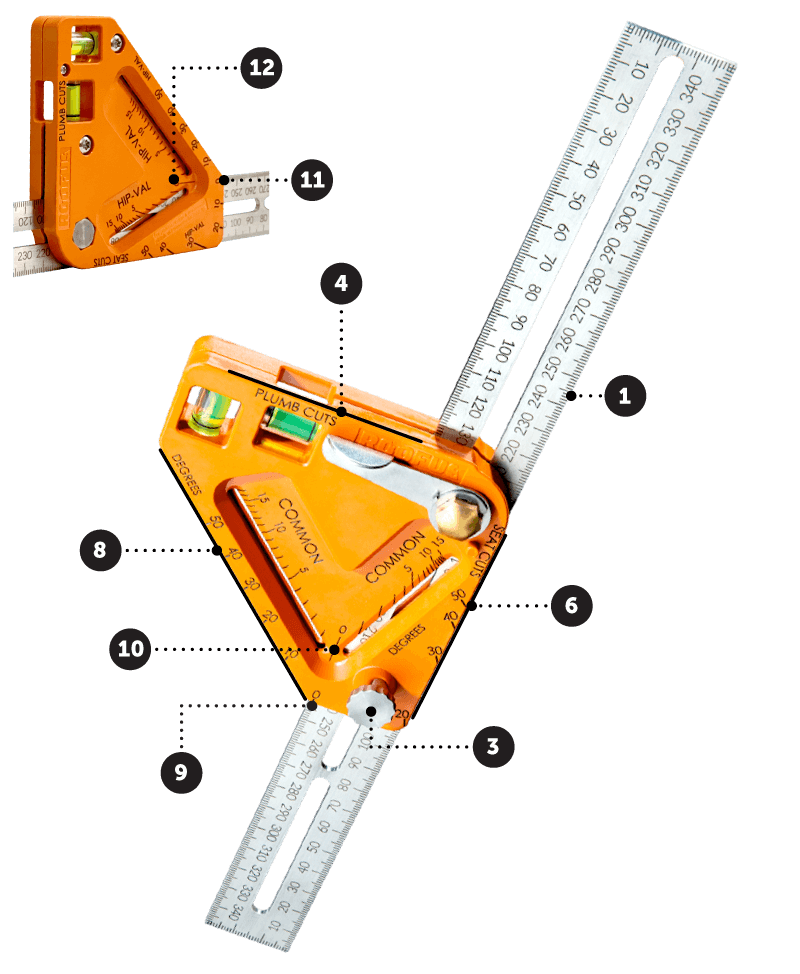

With the square lock (3) engaged, The Roofus® can also mark 90-degree and 45-degree angles via reference of edges (4) and (8) on material without any adjustment, up to 256mm (10″) in length.
Roofus® can measure plumb (vertical) effective to 350mm (14″) in length using edge (6), blade (1) and bubble (5), plus, without any adjustment, the added advantage of level (horizontal) measuring, but instead using bubble (7).
90-degree and 45-degree angles can also be marked to specific depths with The Roofus® using the blade lock (2) and graduations on the blade (1).
A marking gauge can also be achieved with The Roofus® for material rips and rectangular checkouts via use of edge (4 or 8) and blade (1). To scratch the surface of what Roofus can do, it can at least mark ANY angle rather than be limited to 90-degrees and 45-degree angles like the combination square and it is practically the same size.
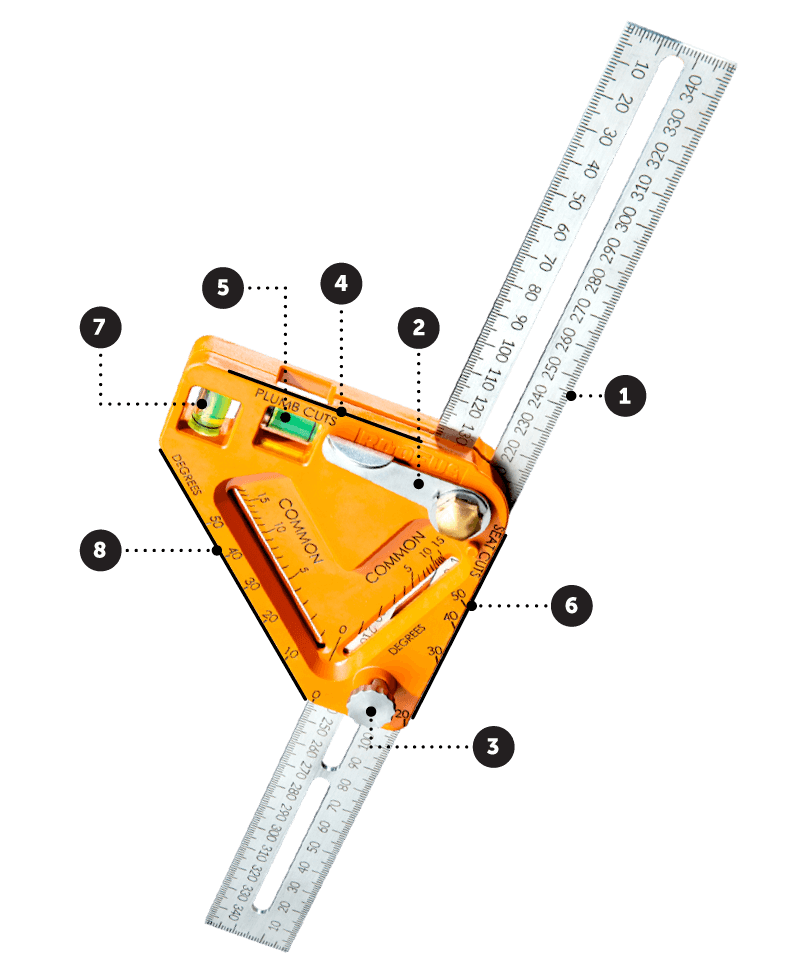

The Roofus® can mark repeatable top/plumb cuts and seat cuts simultaneously via its blade (1) and via reference of edges (4) and (6), plus the unique advantage of adjustable angle depth via blade (1) and blade lock (2). With the square lock (3) engaged, The Roofus® can mark 90-degree and 45-degree angles via reference of edges (4) and (8) on material without any adjustment.
The Roofus® consists of the same three angular scales found on the Quick Square (9,10 & 12), plus the unique advantage of a hip and valley scale calibrated with traditional degrees (11) – exclusive to The Roofus®. Additionally, the degree scale (9) and degree hip-val scale (11) on The Roofus® feature a marking for each degree, rather than a marking for every second degree, as found on the Quick Square.
Variations of a Try square can also be achieved with edges (4) and (6) as the position and depth of the blade (1) is fully adjustable. The Roofus® extends well beyond these capabilities.
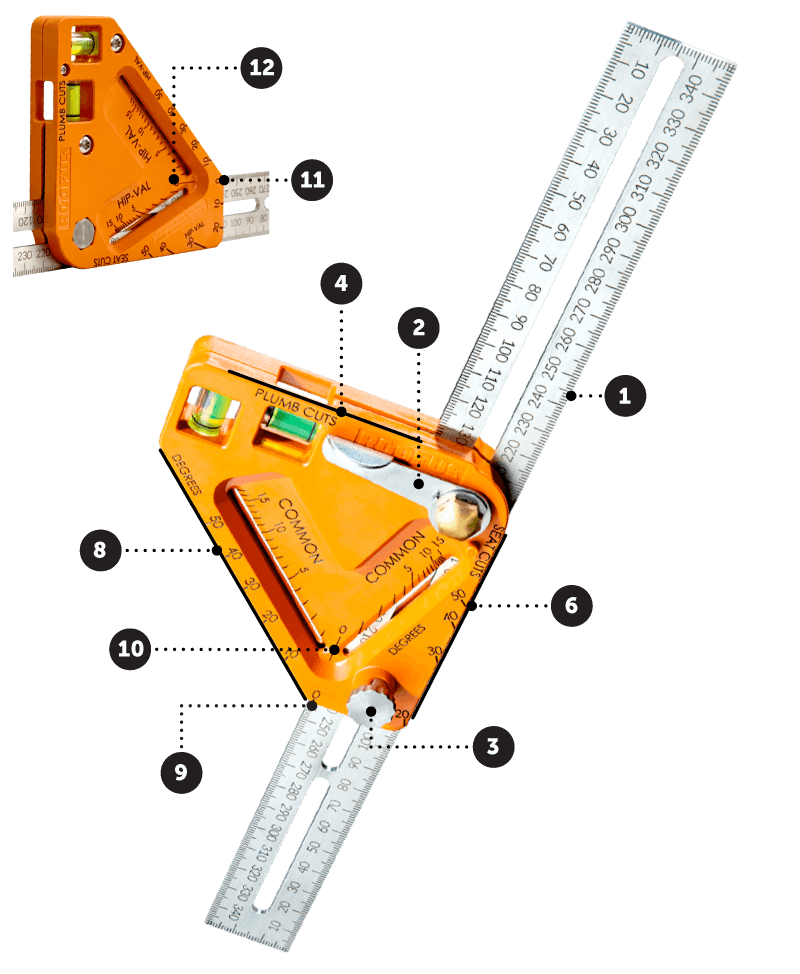

Just like the sliding bevel, The Roofus® is also able to mark any angle measurement in both directions from the edge of a workpiece via edges (4) and (6), with the unique advantage of four angular measurement scales (9,10,11 & 12) which legibly display the angle dispensed, unlike a sliding T bevel which have no featrues to display angle settings. Therefore, the Roofus® does not require working alongside a scrap of wood with reference angle marks, or a 2 foot square for rafter work, as The Roofus® can also mark a seat cut via edge (6) with the blade (1). The Roofus® also consists of two precise hip and valley rafter scales for rise/run (12) and Degrees (11) so you should only need your sliding bevel on a blue moon, or when working in confined spaces if you’ve got a Roofus®.
We have only just scratched the surface of Roofus® and its full capabilities.
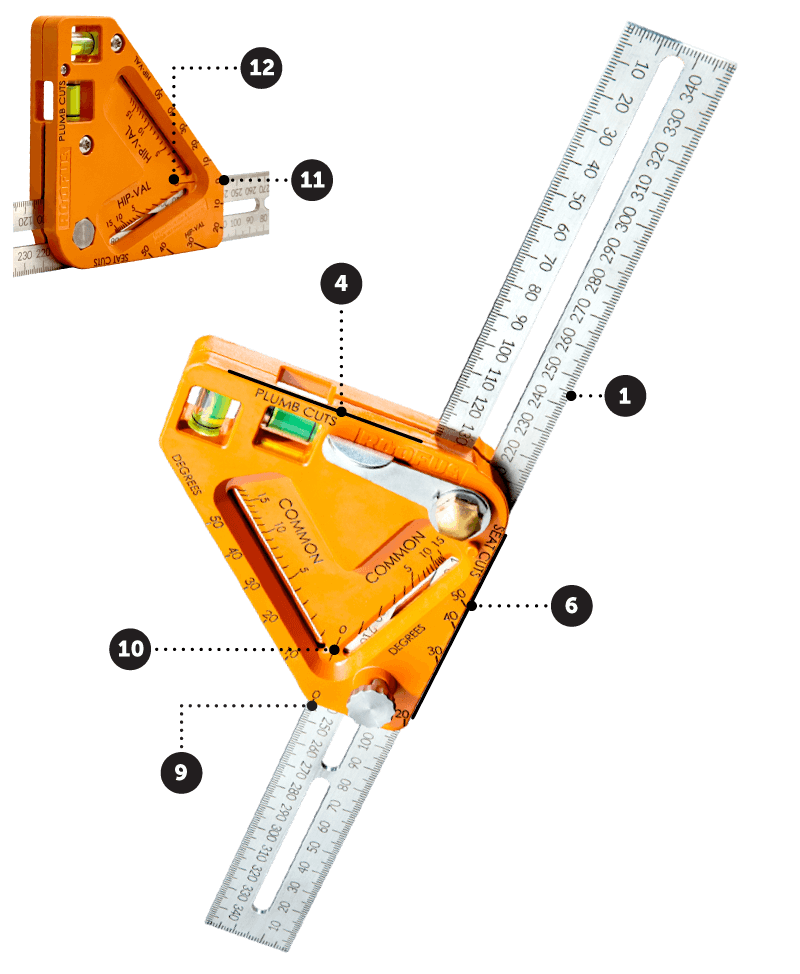

The Roofus® can also mark ANY angle in both directions on a materials edge, via edges (4) and (6) without adjustment, as Roofus® can be flipped over and used on both sides just like a bevel protractor. Precise angular settings of up to 0.3-degrees in accuracy are possible with The Roofus®, especially when using the external angle scales (11) or (9).
Any angle measurement set to a specific depth is also achieved easily with The Roofus® using the graduated blade (1), edge (4) or (6) as reference, and the blade lock (2).
Plumb can be measured effective to 350mm or 14″ in length using edge (6), blade (1) and bubble (5), plus the unique advantage of level measuring instead using bubble (7), also effective to 350mm or 14″ in length.
We have only just scratched the surface of Roofus® and its full capabilities.
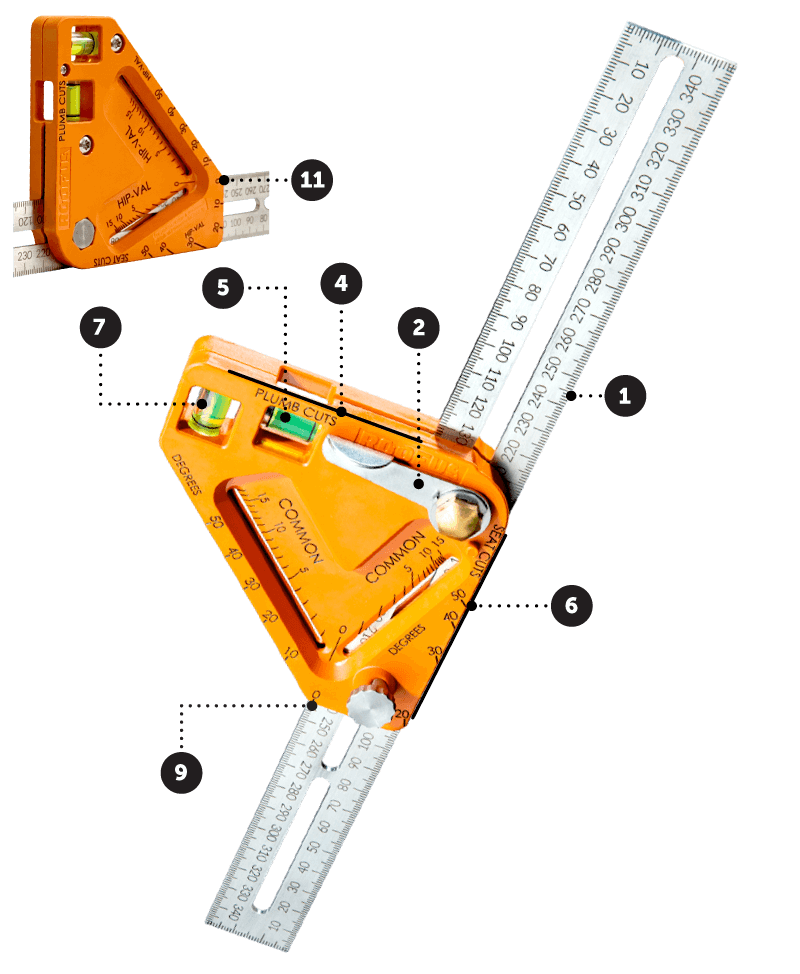
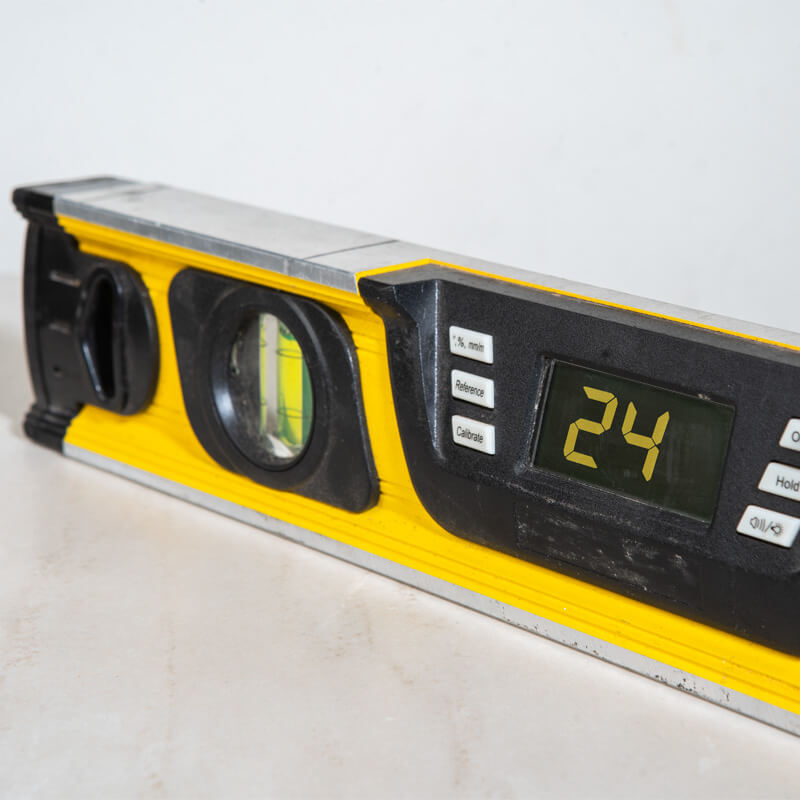
Using The Roofus® adjusted as shown with the blade (1) engaged to the square lock (3), it can measure plumb (vertical) and level (horizontal) via reference of edge (6), effective to the full length of the blade (1), using bubbles (5) and (7).
With both locks (2) and (3) disengaged, the blade (1) can be rested against any surface to measure its angle or pitch by levelling of bubble (5) or bubble (7), then engaging the blade lock (2), and referring to the relevant angle scale for a measurement. Bubble (7) is used for measuring an incline of up to 55-degrees and bubble (5) is required for measuring inclines greater than 55-degrees measured from level (horizontal) plane. The Roofus® can also be set to a specific pitch via any of its four provided angle scales and used to erect for example, a rafter to this specific pitch using the bubbles (7) or (5). Angle readings or markings as precise as 0.3-degrees can be provided by The Roofus® and lastly, no batteries are required.
.
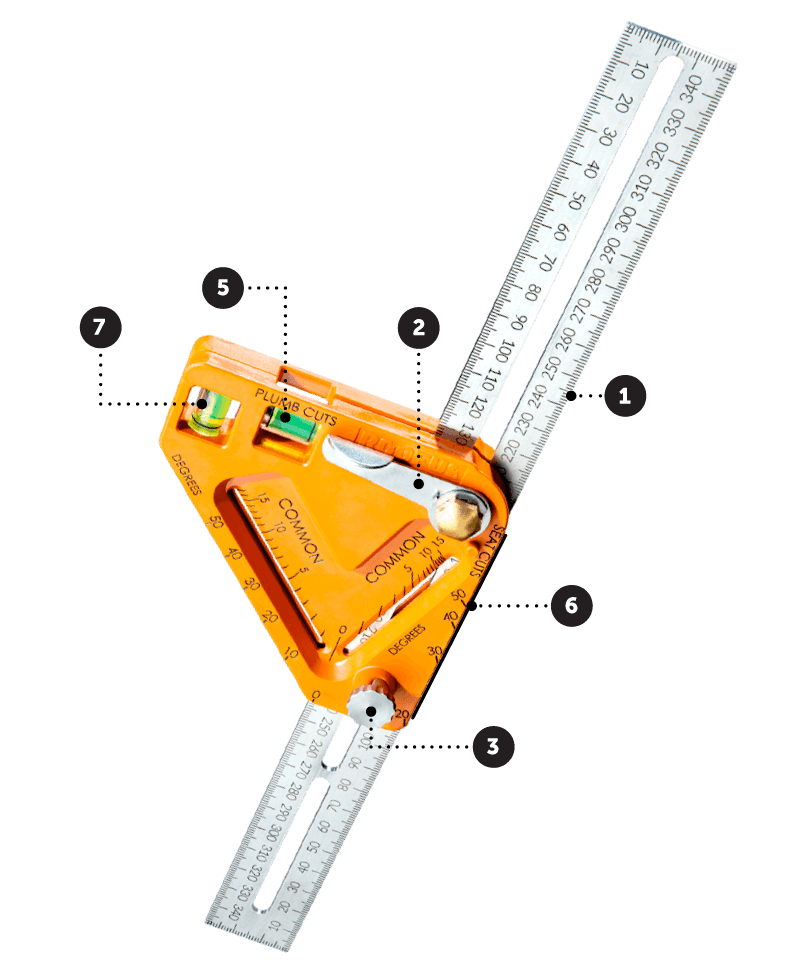

A builders protractor can mark an angle between 90 and about 10-degrees in only one direction from a material’s edge, requiring re-adjustment to achieve the opposite direction as they cannot be flipped over to achieve this opposing direction. The marking of ANY angle in both directions from the materials edge can be achieved with The Roofus® via edges (4) or (6) without adjustment, as it can be flipped over and used on both sides, unlike a builders protractor. Angular measurement readouts on The Roofus® via angle scales (9,10,11&12) are also far more accurate and reliable as they are determined by the blade’s inner facing machined edge instead of a wobbly red arrow pointer as found on these protractors. We have only just scratched the surface of what Roofus® can do.
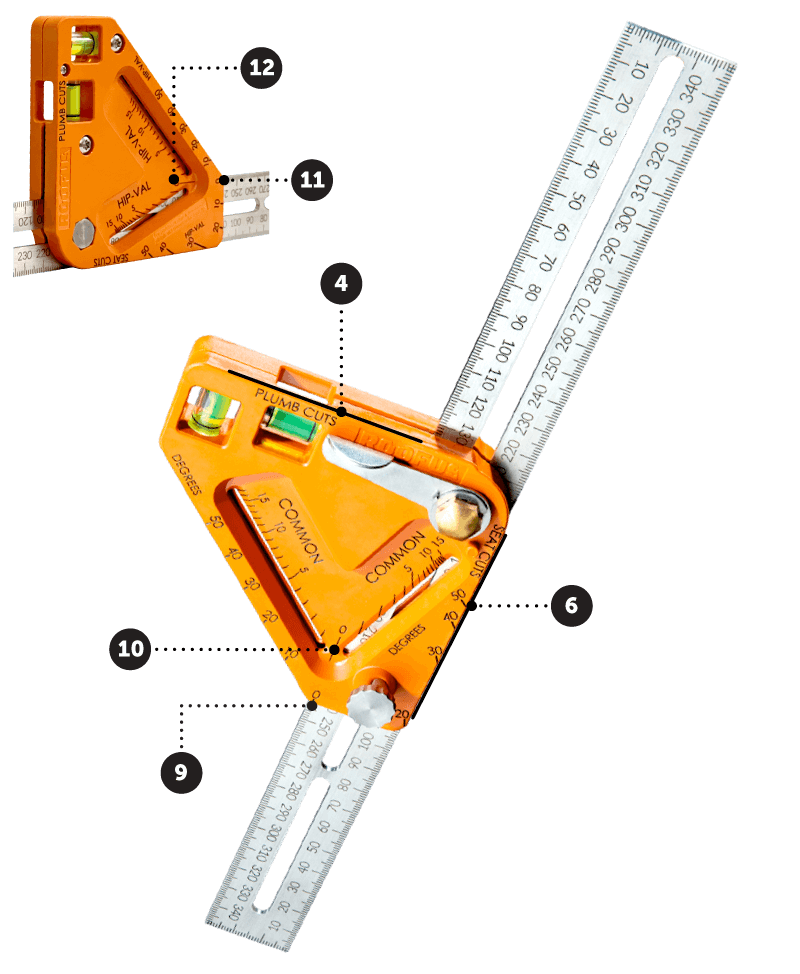

With the square lock (3) engaged, The Roofus® can mark 90-degree and 45-degree angles via reference of edges (4) and (8) on material without any adjustment, whereas the Squangle requires adjustment between application of these two primary angles. The Roofus® can mark plumb cuts via edge (4) simultaneously with seat cuts via its purpose-designed reference edge (6) and at any angle desired. The Squangle cannot mark angles less than 45-degrees with this being its biggest limitation, yet The Roofus® has no angle measurement limitations and is able to mark anything from 0.5-degrees to 90-degrees.
The Roofus® can also compliment a try square via edges (4) and (6) but thankfully without the need for disassembly and reassembly as required with a Squangle to achieve the same function.
Quick Tip for Squangled rafter birdsmouths
Traditional birds-mouth depth measurements should be taken from the top of the rafter to accommodate for any variance in lumber height, keeping the roof surface flat and primarily, roof eaves straight and precise. A Squangle has the capability of marking small repeatable rafter birds mouths (heel cut and seat cut simultaneously) from the underside of the rafter which is practical in only raked ceiling applications, or on precisely machined width lumber. The Roofus® is not limited in this way and is able to mark repeatable birds-mouths referenced from either edge of the lumber or material making Roofus® suitable for any rafter or ceiling application.
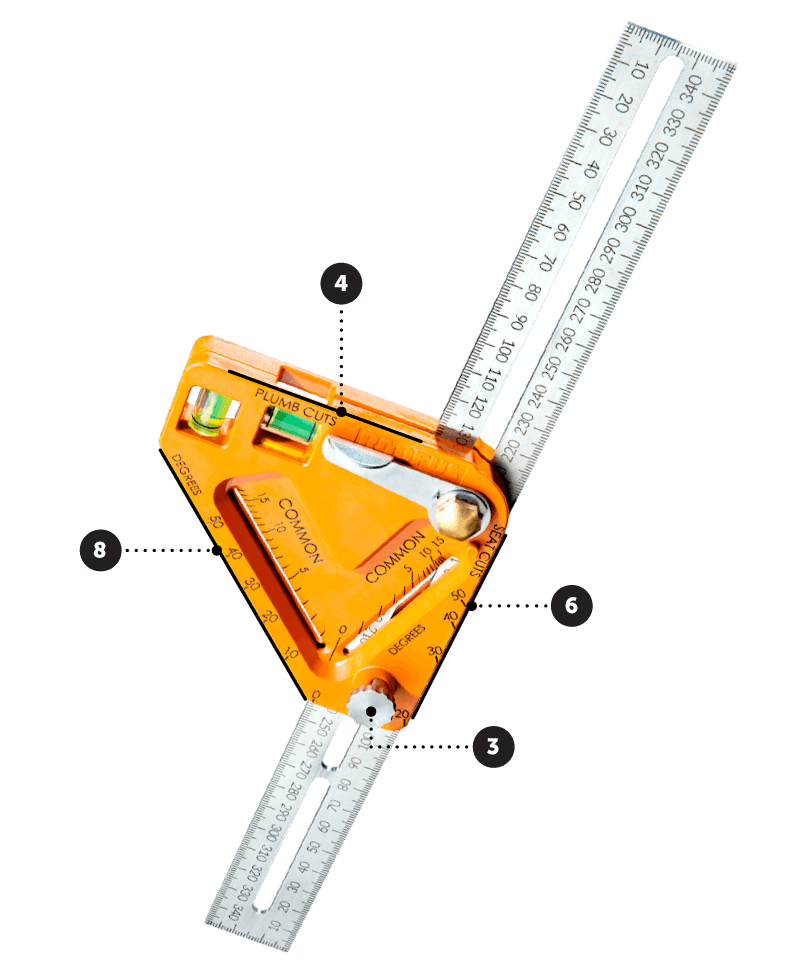
After using the Roofus, you will ask yourself how you ever got by without it in the first place. It is bound to become your most used tool